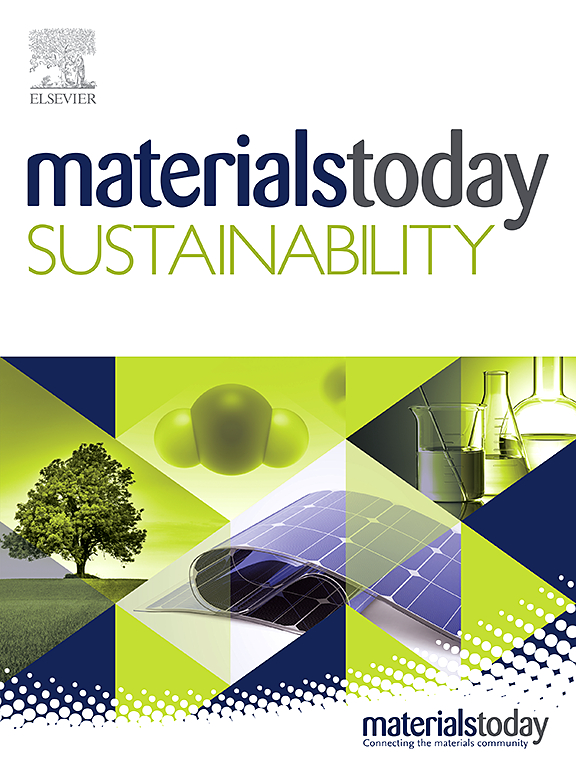电弧炉炉渣对可持续地聚合物混凝土生产的关键分析
IF 7.1
3区 材料科学
Q1 GREEN & SUSTAINABLE SCIENCE & TECHNOLOGY
引用次数: 0
摘要
钢铁工业正在进行重大转型,以满足对钢铁及其零部件日益增长的需求。一般来说,钢铁的生产是一个连续的过程,使用各种不同的炉子,包括高炉(BF)、碱性氧炉(BOF)、综合炉(BF和BOF)和电弧炉(EAF),它们的操作条件不同。其中,电炉已成为钢铁生产的可持续解决方案,因为它利用了回收的废钢和合金。然而,利用电炉加工钢铁会产生工业废渣,需要适当的再利用,以防止污染环境。电炉炉渣含有锌(Zn)、锰(Mn)、镍(Ni)、镉(Cd)、铬(Cr)、铝(Al)等重金属,如果在垃圾填埋场处理,会对水和土壤构成威胁,而焚烧既耗能又昂贵。因此,一个可持续的、具有成本效益的解决方案势在必行。由废料制成的地聚合物混凝土在强度和耐久性方面具有许多优点。尽管如此,关于电炉渣对地聚合物混凝土的影响的文献还很缺乏。电炉炉渣有潜力作为集料或火山灰材料用于地聚合物复合材料。在地聚合物复合材料中回收电炉炉渣不仅促进了环境的可持续性,而且减少了温室气体的排放。本文综述了电炉炉渣在地聚合物复合材料中的应用,考察了其在矿物组成、形态特征、环境后果、管理等方面的协同作用,以及对地聚合物复合材料硬化性能的影响。本文章由计算机程序翻译,如有差异,请以英文原文为准。
A critical analysis of electric arc furnace (EAF) slag for sustainable geopolymer concrete production
The iron and steelmaking industry is undergoing significant transformation to meet the rising demand for steel and its components. Generally, the production of steel is a continuous process carried out by using various furnaces, including blast furnaces (BF), basic oxygen furnaces (BOF), integrated furnaces (BF and BOF), and electric arc furnaces (EAF), with distinct operating conditions. Among these, the EAF has emerged as a sustainable solution for steel production due to its utilization of recycled steel scraps and alloys. However, the processing of steel using EAF generates waste industrial slag that requires appropriate reuse to prevent environmental contamination. The EAF slag contains heavy toxic metals such as zinc (Zn), manganese (Mn), nickel (Ni), cadmium (Cd), chromium (Cr), aluminium (Al), posing risks to water and soil if disposed of in landfills, while incineration is both energy-intensive and costly. Therefore, a sustainable and cost-effective solution is imperative. Geopolymer concrete, made from waste materials, offers numerous advantages in terms of strength and durability. Despite this, there is a lack of literature on the effects of EAF slag on geopolymer concrete. The EAF slag has the potential to be utilized as aggregates or as a pozzolanic material in geopolymer composites. Recycling EAF slag in geopolymer composites not only promotes environmental sustainability but also reduces greenhouse gas emissions. This comprehensive review explores the application of EAF slag in geopolymer composites, examining its synergistic effects on the mineralogical composition, morphological characteristics, environmental consequences, and management, as well as its impact on the hardened properties of geopolymer composites.
求助全文
通过发布文献求助,成功后即可免费获取论文全文。
去求助
来源期刊

Materials Today Sustainability
Multiple-
CiteScore
5.80
自引率
6.40%
发文量
174
审稿时长
32 days
期刊介绍:
Materials Today Sustainability is a multi-disciplinary journal covering all aspects of sustainability through materials science.
With a rapidly increasing population with growing demands, materials science has emerged as a critical discipline toward protecting of the environment and ensuring the long term survival of future generations.
 求助内容:
求助内容: 应助结果提醒方式:
应助结果提醒方式:


